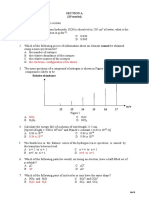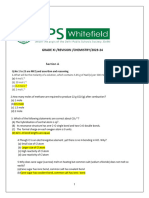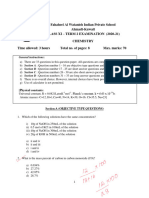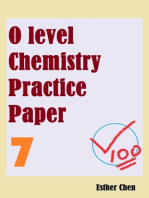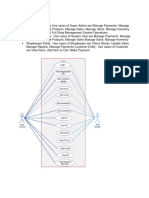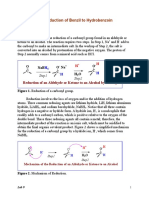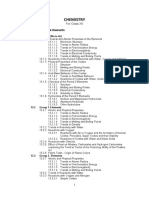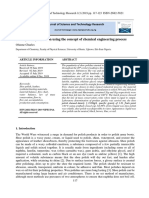Professional Documents
Culture Documents
Chemistry
Chemistry
Uploaded by
SOMOSCOOriginal Description:
Copyright
Available Formats
Share this document
Did you find this document useful?
Is this content inappropriate?
Report this DocumentCopyright:
Available Formats
Chemistry
Chemistry
Uploaded by
SOMOSCOCopyright:
Available Formats
NASIHA ACADEMY EDUCATIONAL SERVICES
2nd TERM EXAMINATION 2023
SUBJECT: CHEMISTRY
CLASS: SSS 1
Instruction: Answer all question
1. One (1) mole or twelve (12) grams of carbon – 12 contains _______
(a) 6.02 x 1023 atoms (b) 6.022 x 1023 atoms (c) 6.04 x 1023 atoms
2. The number 6.02 x 1023 is known as ________ (a) Atom (b) Number
(c) Avogadro number
3. The empirical formula of water is ________ (a) OH (b) HO (c) H 2O
4. The empirical formula of hydrogen perioxide is _______ (a) H 2O
(b) OH (c) HO
5. Metals exhibit ______ oxidation numbers while non – metals tend to
have _______ oxidation number (a) positive and negative (b)
negative and positive (c) positive and positive
6. The formula for ammonium is _______ (a) NH3 (b) NH2 (c) NH4
7. The valency of hydrogen-trioxocarbonate (IV) is ___ (a) 2 (b) 0 (c) 3
8. The symbol for phosphorus is ______ (a) P (b) K (c) Ar
9. The symbol for chlorine is _____ (a) C (b) H (c) Cl
10. The atomic number of chlorine is _______ (a) 7 (b) 8 (c) 17
11. The law of _________ states that matter is neither created nor
destroyed during chemical reaction but changes from one form to
another (a) conservation of mass (b) definite proportions (c) multiple
proportions
12. _______ is the combining power of an element (a) valency (b)
element (c) chemical
13. The force of attraction between covalent molecules is ________
(a) dative bonding (b) hydrogen bonding (c) ionic force (d) van der
waals
14. The following are properties of electrovalent compounds except
(a) they contain aggregates of ions (b) dissolve in water and other
polar solvent (c) good conductors of electricity (d) dissolve in non –
polar solvent
15. Van der waals forces are the dominant intermolecular forces in
(a) ammonium chloride (b) chloride (c) sodium chloride (d) water
SECTION B
Answer any three (3) questions
1. The electronic configuration of element X and Y are as follows
Element Electronic Configuration
X 2,8,8,1
Y 2,7
1a. Write the formula of the compound formed when they combine
1b. Name the type of bonding involved
1c. Will the resulting compound be soluble in water?
1d. Will the compound have a high or low melting point?
2. Consider the reaction between ammonia molecules (NH 3) and a
proton (H+) to form an ammonium ion NH+4
3. What is the mass of 3 moles of oxygen gas O2 (O=16)
3b. How many atom are there in 6g of carbon C?
(1 mole = 6 x 1023, C = 12)
4. Draw the electronic configuration of
i. Oxygen
ii. Neon
iii. Calcium
iv. Fluorine
5. Show the co-ordinate covalent bond reaction between ammonia
molecule (NH3) and a proton (H+) to form an ammonium ion NH+4
You might also like
- Design and Implementation of Students Records WebsiteDocument30 pagesDesign and Implementation of Students Records WebsiteSOMOSCONo ratings yet
- ARCHER - D42.31-Review and Data CollectionDocument55 pagesARCHER - D42.31-Review and Data CollectionAnsarNo ratings yet
- Chemistry WorksheetsDocument16 pagesChemistry Worksheetsapi-262668586100% (2)
- Chemistry MQP Ii Puc 2023-24Document4 pagesChemistry MQP Ii Puc 2023-24Shruthi A R RamNo ratings yet
- 1st year Full Book TestsDocument2 pages1st year Full Book TestsAmber AminNo ratings yet
- Chemistryquestion Paper2022 College DuniaDocument13 pagesChemistryquestion Paper2022 College DuniarachitmutyalwarNo ratings yet
- KTESP SEM 1 TRIAL 2017 With AnswerDocument7 pagesKTESP SEM 1 TRIAL 2017 With AnswerShima SenseiiNo ratings yet
- Chemistry SS IiDocument7 pagesChemistry SS IiAbba YakubuNo ratings yet
- Guess Paper First Year Chemistry by Pakistan College of Science and Commerce Multan 2024Document4 pagesGuess Paper First Year Chemistry by Pakistan College of Science and Commerce Multan 2024حورم فاطمہNo ratings yet
- Final Exam (Sample Question Paper)Document5 pagesFinal Exam (Sample Question Paper)Salim MoniNo ratings yet
- Practise Paper - Chemistry - Class XI 2023-24Document6 pagesPractise Paper - Chemistry - Class XI 2023-24mysixthidisNo ratings yet
- 2021 49 56 Past PaperDocument10 pages2021 49 56 Past PapersikandarhammadhashmiNo ratings yet
- WAEC GCE 2008 Chemistry Paper 2 Questions 1 - 6 With AnswersDocument23 pagesWAEC GCE 2008 Chemistry Paper 2 Questions 1 - 6 With AnswersTaiwoNo ratings yet
- Bodhi Anup XII CHEMISTRY - 1Document8 pagesBodhi Anup XII CHEMISTRY - 1mitra cbseNo ratings yet
- Chemistry Final Exam QuestionDocument4 pagesChemistry Final Exam QuestionKo SaiNo ratings yet
- Chemical Bonding Practice QuestionDocument4 pagesChemical Bonding Practice QuestionAbhay VishwakarmaNo ratings yet
- SQP 20 Sets ChemistryDocument145 pagesSQP 20 Sets ChemistrySky Sir50% (4)
- SBC Term Tedt Aper Chemistry 1 Cover Page 2022 Grade 12 First Term Tets APrilDocument13 pagesSBC Term Tedt Aper Chemistry 1 Cover Page 2022 Grade 12 First Term Tets APrilPiyumi ObeyesekeraNo ratings yet
- Chem 1 & 2Document4 pagesChem 1 & 2Fashola AbdulhamidNo ratings yet
- Chem Rev WorksheetDocument7 pagesChem Rev WorksheetanasuyaNo ratings yet
- Class Xi - Chemistry - Annual Exam - Set II - Sample Paper (2023-24)Document5 pagesClass Xi - Chemistry - Annual Exam - Set II - Sample Paper (2023-24)sanketjha491No ratings yet
- SQP 20 Sets ChemistryDocument144 pagesSQP 20 Sets Chemistrypoornima9739100% (1)
- 11 ChemistryDocument4 pages11 ChemistryYugantNo ratings yet
- Question Paper and Marking Scheme of ChemistryDocument10 pagesQuestion Paper and Marking Scheme of Chemistrytoyirtao7No ratings yet
- ChemistryDocument6 pagesChemistry202.00018.12.0065No ratings yet
- CBSE Class 12 Chemistry Question Paper 2020 Set 3Document8 pagesCBSE Class 12 Chemistry Question Paper 2020 Set 3Rajendra SolankiNo ratings yet
- ChemistryDocument6 pagesChemistrysanketjha491No ratings yet
- TN 11th Chemistry Model Question Paper 2018 WWW - Governmentexams.co - inDocument9 pagesTN 11th Chemistry Model Question Paper 2018 WWW - Governmentexams.co - inJohn alexanderNo ratings yet
- Xi Chemistry (Set-A) Mid Term 2023-24 (110 Copies)Document5 pagesXi Chemistry (Set-A) Mid Term 2023-24 (110 Copies)ayush.private.xxNo ratings yet
- Ib HL Chemistry 1 Midterm ReviewDocument15 pagesIb HL Chemistry 1 Midterm Reviewlngo_4No ratings yet
- ChemistryDocument143 pagesChemistryAFZ EDITZNo ratings yet
- Success Key Test Series Subject: Chemistry: Annual ExaminationDocument4 pagesSuccess Key Test Series Subject: Chemistry: Annual ExaminationBhavesh AsapureNo ratings yet
- Chemistry Sample Papers Class XiDocument26 pagesChemistry Sample Papers Class Xijayanti obcNo ratings yet
- The Pinewood International Senior Secondary School Class - 11Document2 pagesThe Pinewood International Senior Secondary School Class - 11k6n6mgmrmnNo ratings yet
- QP 2432Document4 pagesQP 2432yashojayoneplusNo ratings yet
- Gtavm t01 Quarterly C11a2 Che SKDocument11 pagesGtavm t01 Quarterly C11a2 Che SKPreethaLalNo ratings yet
- hsc-2020 March Chemistry-March-2020-Std-12th-Science-Hsc-Maharashtra-Board-Question-PaperDocument4 pageshsc-2020 March Chemistry-March-2020-Std-12th-Science-Hsc-Maharashtra-Board-Question-Paperutkarshnarkhede56No ratings yet
- FLP Chem Int+gen+legDocument2 pagesFLP Chem Int+gen+legTariq RayNo ratings yet
- Past Paper Chemistry 1st Year BISE Lahore 2006 and 2005Document6 pagesPast Paper Chemistry 1st Year BISE Lahore 2006 and 2005Mian EjazNo ratings yet
- Chemistry March 2020 STD 12th Science HSC Maharashtra Board Question PaperDocument4 pagesChemistry March 2020 STD 12th Science HSC Maharashtra Board Question PaperJava WalaNo ratings yet
- Board Question Paper: 2020: FebruaryDocument4 pagesBoard Question Paper: 2020: February45 C- Raj DabadeNo ratings yet
- SS1 ChemistryDocument4 pagesSS1 Chemistryibrahimabdulmalik707No ratings yet
- Class 11 CHEMISTRY - Term2 Exam Question Paper (1) - 2020-21 2Document8 pagesClass 11 CHEMISTRY - Term2 Exam Question Paper (1) - 2020-21 2moiiifitbituserNo ratings yet
- Xi Chem Sample Question Paper-3Document5 pagesXi Chem Sample Question Paper-3HARSHAL NANDURKARNo ratings yet
- SS1 Chemistry Third TermDocument3 pagesSS1 Chemistry Third TermALALADE VICTORNo ratings yet
- Sample Paper 1: Class XII 2023-24 ChemistryDocument8 pagesSample Paper 1: Class XII 2023-24 ChemistryBhavini TrivediNo ratings yet
- CHM101Document44 pagesCHM101YunusNo ratings yet
- CBSE Class 12 Chemistry 14 Apr Sample Paper 2023 24Document8 pagesCBSE Class 12 Chemistry 14 Apr Sample Paper 2023 24Vinoth RNo ratings yet
- CBSE Class 12 Chemistry 14 Apr Sample Paper 2023 24Document8 pagesCBSE Class 12 Chemistry 14 Apr Sample Paper 2023 24aknishad71385No ratings yet
- ICSE Class 8 Chemistry Sample Paper 1Document7 pagesICSE Class 8 Chemistry Sample Paper 1Laxmi Pathak100% (1)
- Chemical BondingDocument4 pagesChemical Bondingbooksale SiNo ratings yet
- Xi Chemistry (Set-A) Final Term 2023-24 (110 Copies)Document7 pagesXi Chemistry (Set-A) Final Term 2023-24 (110 Copies)ayush.private.xxNo ratings yet
- 111上試題 (含解答)Document8 pages111上試題 (含解答)wanyun345No ratings yet
- CHEMISTRYDocument18 pagesCHEMISTRYEseogheneNo ratings yet
- QP Xii Chem Pt-3 23-24Document5 pagesQP Xii Chem Pt-3 23-24Swastik DasNo ratings yet
- CHEM 11th CBSE (DAV) CH 1,2,3,4,7-1Document6 pagesCHEM 11th CBSE (DAV) CH 1,2,3,4,7-1B2D Bored boiNo ratings yet
- SET PAPER 5 - CHEM Eklavya (XII-CBSE) 01.02.2024 FULL (WM)Document5 pagesSET PAPER 5 - CHEM Eklavya (XII-CBSE) 01.02.2024 FULL (WM)Rahul YadavNo ratings yet
- 11 Chemistry Sample PapersDocument10 pages11 Chemistry Sample PapersPc xoixaNo ratings yet
- PU Board Model Paper With Water MarkDocument12 pagesPU Board Model Paper With Water MarkNaveen KumarNo ratings yet
- Class 11 Chemistry Holiday AssignmentDocument6 pagesClass 11 Chemistry Holiday AssignmentyanuezioNo ratings yet
- Uses Case DiagramDocument2 pagesUses Case DiagramSOMOSCONo ratings yet
- CivicDocument2 pagesCivicSOMOSCONo ratings yet
- Umar Bala Com115 AssDocument6 pagesUmar Bala Com115 AssSOMOSCONo ratings yet
- CivicDocument2 pagesCivicSOMOSCONo ratings yet
- AgricultureDocument2 pagesAgricultureSOMOSCONo ratings yet
- PhysicsDocument2 pagesPhysicsSOMOSCONo ratings yet
- Social StudiesDocument3 pagesSocial StudiesSOMOSCONo ratings yet
- Basic TechDocument2 pagesBasic TechSOMOSCONo ratings yet
- Nurs 3401 General MicrobiologyDocument132 pagesNurs 3401 General MicrobiologySOMOSCONo ratings yet
- Home EconomicsDocument2 pagesHome EconomicsSOMOSCONo ratings yet
- MathsDocument2 pagesMathsSOMOSCONo ratings yet
- Nurs 3309 Medico-Surgical Nursing 1Document118 pagesNurs 3309 Medico-Surgical Nursing 1SOMOSCONo ratings yet
- The ANS and Adrenal MedullaDocument24 pagesThe ANS and Adrenal MedullaSOMOSCONo ratings yet
- Advance Radio and Television Techniques For HND IIDocument14 pagesAdvance Radio and Television Techniques For HND IISOMOSCONo ratings yet
- Advance Radio and Television Techniques For HND IIDocument14 pagesAdvance Radio and Television Techniques For HND IISOMOSCONo ratings yet
- Machine LearningDocument13 pagesMachine LearningSOMOSCONo ratings yet
- Importance of Business Policy From The Viewpoint of Career ChoiceDocument5 pagesImportance of Business Policy From The Viewpoint of Career ChoiceSOMOSCONo ratings yet
- Computer Project TopicsDocument8 pagesComputer Project TopicsSOMOSCONo ratings yet
- Com 122 Pract.Document9 pagesCom 122 Pract.SOMOSCONo ratings yet
- HND 1A Interpersal Communication Handout RealDocument19 pagesHND 1A Interpersal Communication Handout RealSOMOSCONo ratings yet
- Internet QuestionDocument4 pagesInternet QuestionSOMOSCONo ratings yet
- Business Project TopicsDocument4 pagesBusiness Project TopicsSOMOSCONo ratings yet
- Computerized System For Testing Diagnosis and Prescription of Malaria DrugsDocument9 pagesComputerized System For Testing Diagnosis and Prescription of Malaria DrugsSOMOSCONo ratings yet
- Lab 09 A Reduction Reaction - Benzil To HydrobenzoinDocument7 pagesLab 09 A Reduction Reaction - Benzil To HydrobenzoinkrlinzNo ratings yet
- Instant Download Monoamine Oxidase Methods and Protocols Methods in Molecular Biology 2558 Claudia Binda (Editor) PDF All ChapterDocument64 pagesInstant Download Monoamine Oxidase Methods and Protocols Methods in Molecular Biology 2558 Claudia Binda (Editor) PDF All Chapterneyandimpal100% (4)
- Metal Clusters:: Structure and Bonding in Higher BoranesDocument23 pagesMetal Clusters:: Structure and Bonding in Higher BoranesSumedha ThakurNo ratings yet
- TDS Nitocote Wallguard IndiaDocument2 pagesTDS Nitocote Wallguard IndiaAnonymous XVEucVMsENo ratings yet
- Worksheet of Class Nine 7Document2 pagesWorksheet of Class Nine 7Badass PolapainNo ratings yet
- A Comparison of Native and Oxidized Norm PDFDocument11 pagesA Comparison of Native and Oxidized Norm PDFKata SzűcsNo ratings yet
- Chemistry: 13. S-And P - Block ElementsDocument8 pagesChemistry: 13. S-And P - Block ElementsAimen AmjadNo ratings yet
- Alcohol, Phenol and EtherDocument21 pagesAlcohol, Phenol and EtherAditya NandaNo ratings yet
- Index of IFRA Standards 47th AmendmentDocument12 pagesIndex of IFRA Standards 47th AmendmentPaul KilerNo ratings yet
- Unit 7 Chemical Changes: Summary QuestionsDocument2 pagesUnit 7 Chemical Changes: Summary QuestionsLei YinNo ratings yet
- Chapter 4 Lecture NotesDocument30 pagesChapter 4 Lecture Notessama abubakerNo ratings yet
- DLL Science 7 Week 1 Q1Document31 pagesDLL Science 7 Week 1 Q1Arjay MolanoNo ratings yet
- Anticariogenic Restorative Materials11dDocument64 pagesAnticariogenic Restorative Materials11dArvindNo ratings yet
- Revision Notes Class 8 Science Chapter 14 - Chemical Effects of Electric CurrentDocument2 pagesRevision Notes Class 8 Science Chapter 14 - Chemical Effects of Electric CurrentArpit SharmaNo ratings yet
- Farouk Project 2Document37 pagesFarouk Project 2TemidayoNo ratings yet
- Ep1987107b1 PDFDocument9 pagesEp1987107b1 PDFJoyce Abegail De PedroNo ratings yet
- Molecular Basis of InheritanceDocument30 pagesMolecular Basis of InheritancemalavikaNo ratings yet
- Civil AmbujaDocument62 pagesCivil AmbujaRohit JaiswalNo ratings yet
- Chapter 2 Wastewater CharacteristicsDocument36 pagesChapter 2 Wastewater CharacteristicsAce ThunderNo ratings yet
- Ligao National High School - Senior High School Science, Technology, Engineering, and MathematicsDocument25 pagesLigao National High School - Senior High School Science, Technology, Engineering, and MathematicsMaria Kyla Peñafiel TeodoroNo ratings yet
- 5.redox Group 2 and Group 7 ExtraDocument10 pages5.redox Group 2 and Group 7 ExtraAnshu MovvaNo ratings yet
- Surface Engineering of Nanomaterials For Improved Energy Stoge - Artigo2Document17 pagesSurface Engineering of Nanomaterials For Improved Energy Stoge - Artigo2Marcio Gabriel MunizNo ratings yet
- Synthesis of Nanomaterial: Solvothermal Method Photochemical Method Electrochemical MethodDocument29 pagesSynthesis of Nanomaterial: Solvothermal Method Photochemical Method Electrochemical MethodPorpin PungetmongkolNo ratings yet
- Design of Experiments To Evaluate Clay Swelling Inhibition by DifferentDocument7 pagesDesign of Experiments To Evaluate Clay Swelling Inhibition by DifferentRyan AlifNo ratings yet
- SuggestedAnswers 09 EDocument15 pagesSuggestedAnswers 09 ERaiNo ratings yet
- FireworksDocument3 pagesFireworksUjjal ChakmaNo ratings yet
- SUIS ADFORS Technical Fabrics EN Avril 2020Document9 pagesSUIS ADFORS Technical Fabrics EN Avril 2020luca.laniNo ratings yet
- CU-2020 B.Sc. (General) Chemistry Semester-III Paper-CC3-GE3 QPDocument4 pagesCU-2020 B.Sc. (General) Chemistry Semester-III Paper-CC3-GE3 QPSatyajitDeyNo ratings yet
- Shoes Polish Production Using The ConcepDocument7 pagesShoes Polish Production Using The ConcepVanshika SacharNo ratings yet






